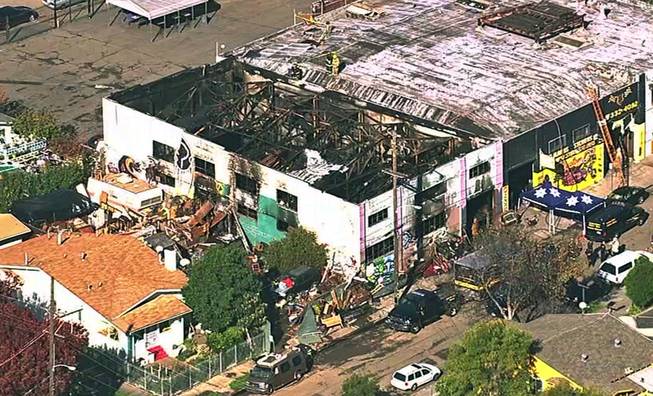
KGO-TV via AP
This image from video shows the Ghost Ship Warehouse on Dec. 3, 2016, after a fire that started late Friday swept through the Oakland, Calif., building.
Saturday, Dec. 10, 2016 | 1:30 a.m.
OAKLAND, Calif. — To set foot in the Ghost Ship on a party night was to pass through the industrial facade of an old warehouse and enter an exotic world glowing with rainbow lanterns, guarded by figures of Asian deities and pulsing with a welcoming vibe.
Performers who came to play the electronic dance party last weekend and those looking to be awed by the sounds and scene wanted to be among people who accepted them for who they were. Straight, gay, transgender, black, white or multiethnic, they wanted a place they could feel safe.
"This party was a cross-section of all those communities, far more than you find in a bar," said Nihar Bhatt, a DJ and promoter who went there to see friends perform. "This is a true counter culture. It's why we call it the underground."
But comfort among kindred spirits masked dangers that now seem hard to have missed after a fire raced through the building and killed 36 people in the deadliest structure fire in the U.S. in 13 years. There were no fire alarms, no sprinklers and the two stairways from the second-floor party did not lead to the building's only two exits.
For those who survived, it was largely a matter of luck that when the first cries of "fire" were heard, they were able to find their way through smoke and darkness or were near enough to a door or already outside.
"To think when I was squeezing out of that gate there were people suffocating inside is such a horrific thought," said Alastair Boone, who had been socializing in a side yard and escaped to the street through a fence. "People were dying right in front of me and I didn't know."
The Ghost Ship was one of many converted warehouses in Oakland that serve as a work and living haven for a mix of musicians and artists — from jewelers to poets to tattoo artists and photographers. The communal living spaces have helped nurture a thriving underground art scene and provided space at a reasonable price in an area where astronomical rent hikes fueled by the tech boom have driven many people out.
Near the heart of the city's industrial Fruitvale section, home to a large Latino population, the warehouse is a short walk from a Bay Area Rapid Transit station where the elevated train frequently whispers past. A retail corridor offers check cashing, quinceanera dresses and taquerias. One of the older establishments in the neighborhood is a large commercial fire extinguisher business a block away.
The warehouse was home to the Satya Yuga Collective founded by Derick Ion Almena, who billed it on Facebook as an "unprecedented fusion" of "bomb bunker helter skelter spelunker shelters and Indonesian straw huts rolling into valleys and down alleys."
Almena and his partner, Micah Allison, leased the warehouse and rented out work and living space to artists and — as noted on Facebook — woodworkers, hot dog vendors, boutique designers and lingerie models. Almena also rented the space for occasional all-night parties. The couple and their three kids were not home the night of the fire.
The building owned by Chor N. Ng, however, was only permitted as a warehouse and the city had opened an investigation last month after neighbors complained about trash piling up and people living inside. A criminal investigation is underway that prosecutors said could lead to charges as serious as murder.
The interior was constantly evolving as a revolving group rotated through and redesigned more than a dozen living spaces.
Upstairs, where Almena, Allison and his family lived, was a public area elaborately decorated in a Bohemian mélange of eastern religious artifacts, tapestries, old furniture and colorful prayer rugs. Organs, pianos and guitars were scattered throughout.
But hazards were many. It was a cluttered labyrinth and much of the construction was built with scrap wood. A mess of electrical cords snaked throughout the building to power everything from appliances to musical equipment to lights. A set of stairs was assembled with stacked up pallets and a ramp that had boards nailed to it as steps.
Bhatt, who had performed there in the past, was wary of all kinds of dangers. As a promotor, he wouldn't put on a show there even though it offered a big dance floor and plenty of unique nooks to socialize in. He didn't want that responsibility. But he would perform and attend events there.
"The reality is there are so few spaces like that" to stage an all-night party, Bhatt said. "We were willing to compromise and take the risk."

Join the Discussion:
Check this out for a full explanation of our conversion to the LiveFyre commenting system and instructions on how to sign up for an account.
Full comments policy